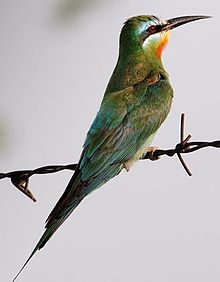- Blue-cheeked Bee-eater
-
Blue-cheeked Bee-eater 
Conservation status Scientific classification Kingdom: Animalia Phylum: Chordata Class: Aves Order: Coraciiformes Family: Meropidae Genus: Merops Species: M. persicus Binomial name Merops persicus
Pallas, 1773The Blue-cheeked Bee-eater, Merops persicus, is a near passerine bird in the bee-eater family, Meropidae. It breeds in Northern Africa, and the Middle East from eastern Turkey to Kazakhstan and India. It is generally strongly migratory, wintering in tropical Africa, although some populations breed and live year round in the Sahel.[1] This species occurs as a rare vagrant north of its breeding range.
Description
This species, like other bee-eaters, is a richly-coloured, slender bird. It is predominantly green; its face has blue sides with a black eye stripe, and a yellow and brown throat; the beak is black. It can reach a length of 31 cm (12 in), with the two elongated central tail feathers adding another 7 cm (2.8 in). Sexes are mostly alike but the tail-streamers of the female are shorter.[1]
This is a bird which breeds in sub-tropical semi-desert with a few trees, such as acacia. It winters in open woodland or grassland. As the name suggests, bee-eaters predominantly eat insects, especially bees, wasps and hornets, which are caught in the air by sorties from an open perch. However, this species probably takes more dragonflies than any other food item. Its preferred hunting perch is telephone wires if available.
Blue-cheeked Bee-eaters may nest solitarily or in loose colonies of up to ten birds. They may also nest in colonies with European Bee-eaters. The nests are located in sandy in sandy banks, embankments, low cliffs or on the shore of the Caspian Sea. They make a relatively long tunnel of 1–3 m (3.3–9.8 ft) in length in which the four to eight (usually six or seven), spherical white eggs are laid. Both the male and the female take care of the eggs, although the female alone incubates them at night. Incubation takes 23–26 days.[1]
The call sounds 'flatter' and less 'fluty' than the European Bee-eater.
Thumamah, KSA 1992
Subspecies
It has two subspecies
- Merops persicus persicus - Breeds in Asia, winters in East and Southern Africa
- Merops persicus chrysocercus - Breeds in North Africa, winters in West Africa.
This species is closely related to Blue-tailed Bee-eater, M. philippinus of East Asia, and the Olive Bee-eater of Africa, and has been treated as being the same species (conspecific).[1]
References
- BirdLife International (2004). Merops persicus. 2006. IUCN Red List of Threatened Species. IUCN 2006. www.iucnredlist.org. Retrieved on 11 May 2006. Database entry includes justification for why this species is of least concern
Bee-eaters (family: Meropidae) Genus SpeciesNyctyornis Meropogon Merops Little Bee-eater • Blue-cheeked Bee-eater • Green Bee-eater • White-throated Bee-eater • Swallow-tailed Bee-eater • Blue-tailed Bee-eater • Black Bee-eater • Blue-headed Bee-eater • Red-throated Bee-eater • White-fronted Bee-eater • Blue-breasted Bee-eater • Cinnamon-chested Bee-eater • Black-headed Bee-eater • Somali Bee-eater • Böhm's Bee-eater • Blue-throated Bee-eater • Olive Bee-eater • Rainbow Bee-eater • European Bee-eater • Chestnut-headed Bee-eater • Rosy Bee-eater • Northern Carmine Bee-eater • Southern Carmine Bee-eaterCategories:- IUCN Red List least concern species
- Meropidae
- Birds of Turkey
- Birds of Iran
- Birds of Kazakhstan
- Birds of Asia
- Birds of Pakistan
- Birds of Morocco
- Birds of Africa
- Birds of South Africa
Wikimedia Foundation. 2010.

